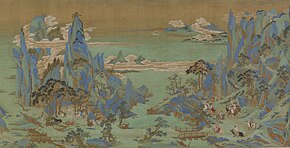Zelenomodré krajiny

Zelenomodré krajiny (čínsky v českém přepisu čching-lü šan-šuej, pchin-jinem qīng-lǜ shān-shuǐ, znaky zjednodušené 青绿山水, tradiční 青 綠山水) je tradiční čínský žánr krajinomalby nazvaný podle převládajících barev – zelené a modré, případně smaragdové a zlaté.
Tradičně za zakladatele žánru považován tchangský malíř Li S’-sün (651–716). Před tchangskou dobou byla v čínské malbě krajina pouze pozadí pro postavy nebo budovy a krajinomalba neexistovala jako samostatný žánr.[1] Li S’-sün a jeho synové zdokonalili malířské techniky a definitivně zformulovali styl krajinomalby, v čínštině doslovně „hory a voda“ (šan-šuej), čemuž odpovídala i barevnost obrazů – zelená a modrá, případně zlatá a smaragdová.
Reference
Externí odkazy
 Obrázky, zvuky či videa k tématu Zelenomodré krajiny na Wikimedia Commons
Obrázky, zvuky či videa k tématu Zelenomodré krajiny na Wikimedia Commons
Média použitá na této stránce
Journey to Shu. Ink and color on silk. Blue-and-green style. H x W (painting): 54.9 x 183.2 cm (21 5/8 x 72 1/8 in). Traditionally attributed to Qiu Ying 仇英 (ca. 1494–1552), Calligraphy by Wen Zhengming 文徵明 (1470–1559). 16th-17th century, Ming dynasty.
Journey to Shu is one of several paintings that depict scenes from the famous love story of the emperor Ming Huang (Emperor Xuanzong) and his concubine Yang Guifei.
Painted in lavish mineral-based colors of blue, green, and brownish yellow, this painting is a typical “blue-and-green” landscape. This style originated during the Tang dynasty (618–907). It was often employed in later periods, such as the Ming dynasty (1368–1644) in this case, to evoke a past era of peace and prosperity. The current painting is modeled on a well-known landscape from the collection of National Palace Museum in Taipei. It was traditionally believed to represent the flight of Emperor Xuanzong (685–762) to Shu (Sichuan) in summer 756 CE during the An Lushan rebellion . However, its composition differs from its model in many ways, including the addition of an entire section of landscape and the conflict of season.
The painting depicts a dramatic landscape of towering blue and green mountains topped with coiling clouds. Four groups of travelers are marching through the landscape. From the right, several women riders, each wearing a piece of red clothing, emerge from the mountains accompanied by several men in front and at the rear. Proceeding left from the bridge, traveling merchants rest among trees. One of their horses rolls happily in the grass. The third group of travelers appear exhausted from the journey. Feeling concerned, the man riding in front looks back at his companions. At left, the fourth group is making their way up the mountain path, which leads to hanging roadways off dangerous cliffs. In the background, a large body of water recedes into the distance. Trees and flowers are blooming, suggesting it is springtime.
Emperor Minghuang's Journey to Sichuan; this section of a much larger en:Ming Dynasty (1368-1644) Chinese handscroll painting on silk shows Tang Minghuang, or en:Emperor Xuanzong of Tang, fleeing the capital en:Chang'an and the violence of the en:An Shi Rebellion that began in the year 755 during the mid en:Tang Dynasty. The scene shown in this painting follows the previous one, en:Yang Guifei Mounting a Horse. This handscroll painting is a late Ming copy after an original painting by the renowned Ming artist en:Qiu Ying (1494-1552).
From the Freer Gallery of Art and Arthur M. Sackler Gallery, the Smithsonian’s National Museum of Asian Art of Washington D.C.
- Author: en:User:PericlesofAthens
- Date: August 3, 2007
